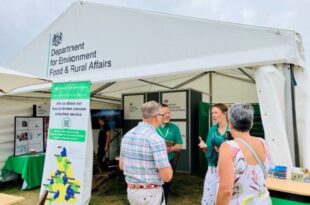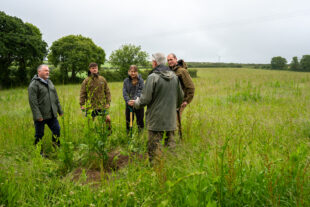https://defrafarming.blog.gov.uk/charlie-edgley-sfi-video-diary-transcript/
Transcript: Charlie's Sustainable Farming Incentive transcript
Good morning, I'm Charlie Edgley, and this Kensham Farms. Kensham Farms is situated in the Chilton Hills in Buckinghamshire.
We are a cereal farm growing predominantly milling wheat which is bread-making wheat for the premium market, growing for Hovis and Warburtons. We grow milling wheat because our soils aren't the best. We're on very steep, stoney, flinty land so rather than going for high yields we go for the premium bread-making market and try and ensure that we get a milling premium each year.
Over the years, the farm has changed. When my father first started farming here in the 1950s, we've had we've had a dairy herd, we've had pigs, we used to have chickens, beef, cattle, we've never had sheep here, but now we're just just an arable farm.
We've invested heavily in technology over the years, the sprayer, the combine, the tractors, all have GPS on them, so this used for steering, and then on the fertiliser spreading and the spraying, it makes sure that we don't have any wastage. We don't have any overlap so we're using our inputs more efficiently, and the combine has yield mapping which we're able to analyse to dictate, are there any ways that we can improve yields?
Cultivation strategy has changed considerably over the years. Up to the mid 2000s, we plowed every acre every year, which on 2,000 acres was a massive undertaking. We had two tractors, two big plows, burning lots of diesel, moving tens of thousands of tons of soil, so we invested in a one-pass, sub-soil cultivator in the late 2000s, and that was able to loosen the soil and cultivate it in one pass. and then just drill it.
And subsequent to that, we've been going shallower and shallower with our cultivations to save money and not release so much carbon, and two years ago we were able to get a grant from the Chiltern Leader project to invest in this machine, which is a Dale direct drill, which means in certain circumstances we're able to plant direct into stubble.
So we take a view on cultivations every year, we look at the crops, we look at the fields, plan the following years that autumn's cultivations. There's a small area still plowed but probably no more than 7 or 8 percent a year. Some areas are deep tilled. If we feel there's compaction, some areas are shallow tilled and some areas are just direct-drilled.
We're taking part in the SFI pilot because we're very concerned about our loss of BPS payments and so we want to engage with Defra's new scheme to try and recover some of those funds, and we felt that possibly if we were involved in the pilot scheme then we might have some influence on on the direction that the new scheme goes in and can try and work out what works and what doesn't work.
On the positive side, I've found the general attitude of Defra to be extremely encouraging and supportive. I think it's great that they're asking farmers to engage and help find out what works and what doesn't work.
On the negative side, it's been quite complicated completing the application but we've got there. And possibly the levels of payment aren't quite as high as we would like for the work involved.
We've applied for the intermediate level for arable land, the advanced level for arable soils, so what that means for the arable land is that the total farm area is around about 850 hectares. Historically we were in Entry Level Stewardship (ELS) for 10 years and when that scheme finished we kept all those ELS features.
We applied for mid-tier stewardship. Our application was successful but we decided not to go ahead with it because we were very worried about fines and penalties. But a lot of those original ELS features are still in place, which were wildflower margins and whatnot.
So for the arable land option, we're going to have nesting cover wildflower strips. They've been in situ for many years so as far as that aspect of the application is concerned, it's business as usual, and in addition some of our land that has been growing crops will be planted with winter bird seed, which we'll be doing the following spring.
On the soil option, we've already planted 200 acres of cover crops with our direct drill. We planted those immediately after harvest and they were a mixture of buckwheat and fodder radish and then those crops were in situ from mid-August to mid-October and they've subsequently been direct drilled with wheat, and seem to be establishing well, although it's still early days at the moment.
So this is one of the cover crops that was direct-drilled into winter wheat stubble after harvest about the third week of August. We've got a mixture of buckwheat mustard and fodder radish here. This cover here will stay in place throughout the Winter and then next Spring we'll be planting this with one of the bird seed mixes.
Now we come across to here, this was also cover crop but this has now been planted with wheat ,and if you look closely you can see the wheat is just coming through and so the the cover crop was sprayed off and it was just, there's no subsequent cultivation, it was just straight in with a seed drill.
This is an area of the field that we've sprayed the cover crop off and it's now being direct drilled with winter wheat, so there's an awful lot of organic material here but you can see that the wheat is all growing up through it and what the cover crop has done.
If I pull this plant up here, you can see it's got a tap root and that's helped punch into the soil and help relieve some compaction and create a bit of tills. It was a bit of a struggle for the drill. You can see we've got some quite big lumps here and there, but the wheat's all coming through well and hopefully the cover crop will have increased the organic matter in the soil and we'll slow-release a little bit of nitrogen next Spring.
See here, we've got some worm activity, there's loads of organic matter here in the soil and you can see the there's another earthworm there, another one there, and you can see that the wheat is just starting to poke through here, there's another wheat coming through there so quite good, good to see in that little area we saw.
Look just here, if you can pan in on that, we've got a nice earthworm there and then we've got another one there, so there's another one there, so just in that small little area we've got plenty of earthworm activity, which is what we like to see.
So this is one of our steeper fields and as you can see all the farm operations are done across the slope rather than up and down. What that does is, it reduces the chance of runoff and erosion and we're hoping that by moving towards shallower and shallower tillage, we're reducing the soil erosion and it's also safer working across the slope rather than up or down as well.
From now on with our soil analyses, we rotationally analyse our soils on probably a 5-year cycle and we're now going to be making sure that those soil analyses include organic matter percentages so that we know we know what percentage of organic matter that we've got in our soils, and we've already had our first results back and the organic matter percentage was much higher than we anticipated, which we're very pleased about.
I would say so far it's been a positive experience. It does take some planning and particularly to do it at the beginning of a cropping year, in case you've got to change areas of crops and give some land up for biodiversity. So having good mapping software and being able to record different areas, I would say is very important to make sure you get to the correct percentages that are required.
The application was quite late in the season because we tend to plan all our fertiliser and cropping requirements in June for the following season. We made the application in July, so I think possibly the Spring might have been a better time, but we found we had enough time to do it, to work out our areas that we're going to be required and to alter any seed orders accordingly to make sure everything was correct for the beginning of the season.
We haven't actually officially begun our scheme yet, we haven't signed any documentation, so we anticipate that happening but we're taking it on trust that, you know, it's going to go ahead OK.
To my mind there's absolutely no doubt we're in a period of massive change, not only with British agriculture, but with the whole climate change and net zero, it's a period of great uncertainty.
I feel that those who are committed to farming, there'll be a place for them. But I am worried about too much productive farmland being put over to rewilding or planting trees or biodiversity, thus reducing the available land for growing food.
And I'm also worried that if we if we're growing less food in this country that we're going to be possibly importing more from abroad, exporting our environmental responsibility abroad, because surely for every tree that's planted on productive arable land in the UK, there are going to be more trees cut down elsewhere across the world to make up for the deficit in food.
We've got to be careful we don't just look at the UK picture. We need to look at the global picture and the fact is that, you know, grain prices are high at the moment, our input costs have gone absolutely through the roof, with fertiliser in some cases nearly tripling in price in the space of 18 months. So it's a worrying time. I think we're in for quite a roller coaster ride, so we'll just have to see how it all works out.



